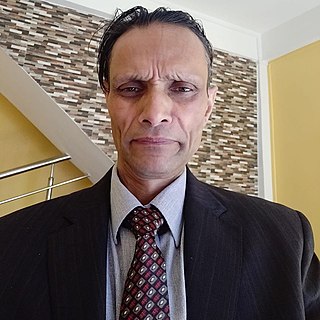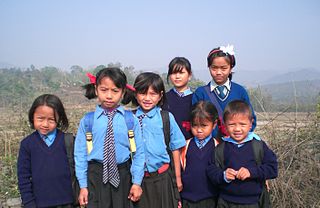
Languages spoken in the Republic of India belong to several language families, the major ones being the Indo-Aryan languages spoken by 78.05% of Indians and the Dravidian languages spoken by 19.64% of Indians; both families together are sometimes known as Indic languages. Languages spoken by the remaining 2.31% of the population belong to the Austroasiatic, Sino–Tibetan, Tai–Kadai, and a few other minor language families and isolates. According to the People's Linguistic Survey of India, India has the second highest number of languages (780), after Papua New Guinea (840). Ethnologue lists a lower number of 456.

Meitei, also known as Manipuri, is a Tibeto-Burman language of northeast India. It is the official language and the lingua franca of Manipur and one of the official languages of Assam. It is one of the constitutionally scheduled official languages of the Indian Republic. Meitei is the most widely-spoken Tibeto-Burman language of India and third most widely spoken language of northeast India after Assamese and Bengali. There are 1.76 million Meitei native speakers in India according to the 2011 census. Most of these, or 1.52 million, are found in the state of Manipur, where they represent majority of its population. There are smaller communities in neighbouring Indian states, such as Assam (168,000), Tripura (24,000), Nagaland (9,500), and elsewhere in the country (37,500). The language is also spoken by smaller groups in neighbouring Myanmar and Bangladesh.
Hmar is a Kuki ethnic group living in Northeast Indian state of Manipur, Mizoram, Assam and western Myanmar (Burma) and eastern Bangladesh. They use Meitei language as their second language (L2) in Manipur. They speak Mizo language as their L1 in Mizoram.
The Hmar language belongs to the Mizo language branch of the Sino-Tibetan family of languages. The speakers of this language use Mizo language as their second language (L2).

Dima Hasao district, is an administrative district in the state of Assam, India. As of 2011, it is the least populous district of Assam.
DD Free Dish is an Indian free-to-air satellite television provider owned and operated by Public Service Broadcaster Prasar Bharati. It was launched in December, 2004. In March 2022, It has a reach of over 43 million households which is more than 25% of the total TV households in the country. DD Free Dish earns by selling slots to private broadcasters through Online auction.
Madhyamik Pariksha or simply Madhyamik is a centralized examination conducted by the West Bengal Board of Secondary Education in West Bengal, India, at the end of the 10th year of school education. Similarly, one examination is also conducted at the state of Tripura for its students studying in Govt or Govt Aided school under the control of Tripura Board of Secondary Education. By count of examinees, it is among the better-known 10th standard examinations in India. In WBSE, over 600,000 students took the exam in 2000, and the number has increased substantially since then. The number of students reached a record 1 million in the 2011 Madhyamik examination. Compulsory subjects are first language, second language, physical science, life science, mathematics, history and geography.
The Board of Secondary Education, Assam commonly known as SEBA, is the state education regulatory board under the jurisdiction of Ministry of Education, Government of Assam for conducting examinations and providing assurance for the quality of education imparted in schools within Assam, India that are affiliated to it. It offers education in English (IL), Assamese, Bengali, Bodo, Hindi, Meitei (Manipuri), Hmar, Nepali, Mizo, Khasi, Garo, Karbi and Urdu languages.
Assam is a state in northeastern India. In 2011, the literacy rate of Assam was estimated to be 73.18% .The literacy rate of Assam is slightly below the national average of 74.04%.

The Board of Secondary Education, Rajasthan (RBSE) or(BSER) is a State Level board of education in the Indian state Rajasthan, for public and private schools, controlled and managed by the Government of Rajasthan. The board is responsible for promotion and development of secondary education in Rajasthan state. RBSE was Established in the year 1957 and constituted under the Rajasthan Secondary Education Act 1957.All schools affiliated to RBSE follow the NCERT curriculum especially from class 9 to 12. The current Chairperson of RBSE is Laxmi Narayan Mantri (IAS).

Madhya Pradesh Board of Secondary Education is a board of school education in Madhya Pradesh State of India.
Williamson Ampang Sangma, was a Garo leader, and the first Chief Minister of Meghalaya. He was also the first ever Governor of Mizoram among the Garos in 1989.
Bengali Unicode block contains characters for the Bengali, Assamese, Bishnupriya Manipuri, Daphla, Garo, Hallam, Khasi, Mizo, Munda, Naga, Riang, and Santali languages. In its original incarnation, the code points U+0981..U+09CD were a direct copy of the Bengali characters A1-ED from the 1988 ISCII standard, as well as several Assamese ISCII characters in the U+09F0 column. The Devanagari, Gurmukhi, Gujarati, Oriya, Tamil, Telugu, Kannada, and Malayalam blocks were similarly all based on ISCII encodings.
The Constitution of India categorizes the tribes of Assam into two groups: Scheduled Tribes (Hills) and Scheduled Tribes (Plains). Since hills tribes living in the plains and plains tribes living in the hills in large numbers are not recognised as scheduled tribes in the respective places, the census data may not reflect the correct figures. Assamese language is used as the lingua franca by almost all the tribes. According to the 2001 census, Scheduled Tribes made up 12.4 percent of Assam's population. The Assam Tribune reported in 2009 that the tribal communities of Assam were accounted for 15.64 percent of the total population.

The Ministry of Electronics and Information Technology (MEITy) is an executive agency of the Union Government of the Republic of India. It was carved out of the Ministry of Communications and Information Technology on 19 July 2016 as a standalone ministerial agency responsible for IT policy, strategy and development of the electronics industry. Under the sponsorship of the Ministry of Electronics and Information Technology, the "Northeast Heritage" Web, owned by the Government of India, publishes information on Northeast India, in 5 Indian languages, Assamese, Meitei (Manipuri), Bodo, Khasi and Mizo, in addition to Hindi and English.
The Eighth Schedule to the Constitution of India lists nationally recognised regional languages of the Republic of India. At the time when the Constitution was enacted, inclusion in this list meant that the language was entitled to representation on the Official Languages Commission, and that the language would be one of the bases that would be drawn upon to enrich Hindi and English, the official languages of the Union. The list has since, however, acquired further significance. The Government of India is now under an obligation to take measures for the development of these languages, such that "they grow rapidly in richness and become effective means of communicating modern knowledge." In addition, candidates sitting for an examination conducted for public service are entitled to use any of these languages as a medium to answer the paper.
Pragya Academy is a Junior College, established in 2010, and located in Jorhat of Assam, India.

Salil Gewali is an Indian researcher, writer and journalist. He is a writer of 18 books, including school textbooks. He is best known for the publication of the book Great Minds on India. The outcome of an extensive research spanning over two decades, the title by Gewali has been translated into thirteen languages.

The hill tribes of Northeast India are hill people, mostly classified as Scheduled Tribes (STs), who live in the Northeast India region. This region has the largest proportion of scheduled tribes in the country.
The population of Assam consist of tribal ethnic groups and linguistic groups such as Assamese, Bengali, Hindi speakers, Nepali and Odia speakers.








